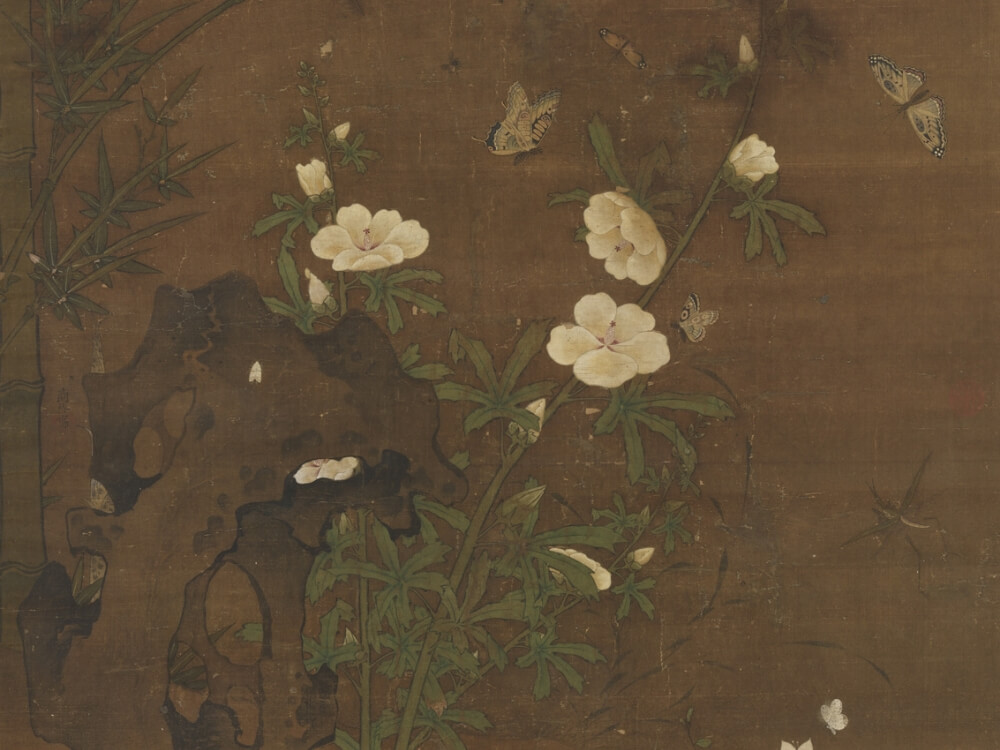Hid-and-Seek Insects
The petite scale of insects makes it sufficient for formats of 'album lea' and 'fan lea' to have caochong paintings. Nonetheless, many caochong were painted on the 'hand scrolls' and 'hanging scrolls'. These works in larger dimensions consist of more variety and quantity of subjects, including insects, small animals, flowers and plants.
When appreciating these larger caochong paintings, it is a breeze to enjoy the pleasure of hide-and-seek. Upon the leaves, beside the rocks, and along the water bank-every corner of the image can surprise you with insects or animals you haven't noticed. Their appearance and movement are wonderfully attractive and make us realize that the liveliness of nature is thriving even in the trivial places; this is the most significant message presented by caochong paintings.
Seeing from the exhibited hand scrolls and vertical scrolls, how many insects have you found? Have you located every single one of the caochong hidden in the picture?
- Okra Flowers
- Shang Zuo (fl. 15th c.), Ming dynasty
The 'Okra Flower' was a rare masterpiece of caochong painting in the hanging-scroll format. In between the gap of bamboo and rock on the left side of the image, there is a signed mark of 'illustrated by Shang Zuo'. Shang Zuo was the grandchild of Shang Xi (15th century), the famous court painter in the Ming dynasty. This painting depicts a corner of a beautiful garden; the composition has the identical style to the flower-and-bird illustrations in hanging scrolls done by other court painters in the 15th century. The spaces consist of peculiar stones, plants and lands, which stand as the performance stage for caochong creatures. For example, intriguing wasp flying back to the nest, dragonflies fighting in the air, a black ladybug confronting a grasshopper on the ground, and a group of ants transporting a carcass of cicada. Shang Zuo's artwork captured the momentum of the hanging scrolls; without having trivial details imbalance the structure. On the other hand, Shang positioned the caochong in places for viewers to locate and discover, gaining the joy of playing hide-and-seek.
Open Data Download
- Flowers
- Chen Lin (1260-1320), Yuan dynasty
This counterfeit piece painted by one posed as the famous Chen Ling (1260-1320) reflected that the flower and caochong were a trend celebrated in the late Ming dynasty.
Look closely at the wild verdure; we'll notice various insects hiding on the land and the water bank. These insects with vibrant colours travel among the lovely plants without fear, and the layout is just like a musical movement performed by all elements.
- Aquatic Life and Insects
- Chang Lun (fl. 16th-17th c.), Ming dynasty
This scroll has painted marine creates such as fish, shrimp, and crab among the aquatic plants to take the lead, followed by insects on the leaves, including butterfly, katydid, locust, mantis, and dragonfly. Each demonstrates the individual movement of flying, jumping or just resting briefly.
The entire scroll embraces the spontaneous expression with minimal ink strokes, delivering a fluent dynamic with distinct rhythm; the use of heavy and light ink echoes the essence of calligraphy and zen paintings.
- Insects
- Zhu Rulin (18th c.), Qing dynasty
This scroll, painted in 1711, uses fine and confident brushstrokes and elegant colours to portray butterfly, bee, longicorn beetle, grasshopper, mantis, and ant; the funny thing is there's a cockroach as well. Zhu Rulin's (1696-later than 1762) faithful representation of various caochong has stood as a precious biological record passed down from the 18th century.
The spaces left on paper were originally Zhu's intention to request individual poems for each insect; unfortunately, once the piece entered the Qing court, only Emperor Qianlong had written one poem on the painting.







